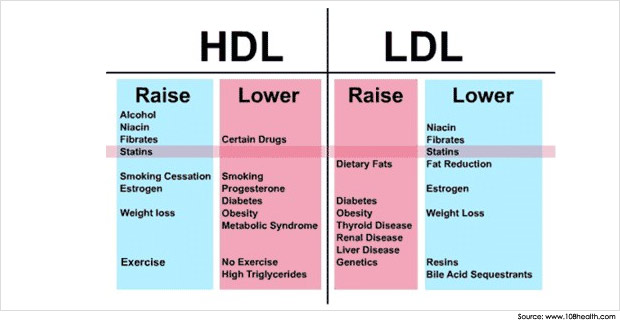High cholesterol is responsible for 70% of heart disease and is the leading killer of both men and women after the age of 45. Abnormal cholesterol levels such as high LDL cholesterol or low HDL cholesterol are a major risk factor for coronary artery disease and stroke.


An unhealthy diet can cause high cholesterol. Sometimes high cholesterol runs in families. A low-cholesterol diet can help improve cholesterol levels. If the low-cholesterol diet does not work to lower bad cholesterol and increase good cholesterol, medications may be necessary.
Cholesterol is made in the liver and other cells and found in certain foods, such as food from meat and dairy products like eggs.
Your body needs some cholesterol in order to function properly. Cell walls etc. need cholesterol in order to produce hormones such as vitamin D and the bile acids that help to digest fat. But your body needs only a limited amount of cholesterol to meet its needs. When too much is present, health problems such as heart disease may develop.
Cholesterol travels through the blood attached to a protein — this cholesterol-protein package is called a lipoprotein. Lipoproteins are classified as high density, low density, or very low density, depending on how much protein there is.
Since cholesterol is essential for all animal life, it is primarily synthesized from simpler substances within the body. However, high levels in blood circulation, depending on how it is transported within lipoproteins, are strongly associated with progression of atherosclerosis.
Cholesterol Values
| mg/dL | mmol/L | |
| Total Cholesterol | ||
| Desirable | < 200 | < 5.1 |
| Borderline high | 200 – 239 | 5.1 – 6.1 |
| High | > 239 | > 6.1 |
| LDL cholesterol – the “bad” cholesterol | ||
| Optimal | < 100 | < 2.6 |
| Near/above optimum | 100 – 129 | 2.6 – 3.3 |
| Borderline high | 130 – 159 | 3.3 – 4.1 |
| High | 160 – 189 | 4.1 – 4.8 |
| Very high | > 189 | > 4.8 |
| HDL cholesterol – the “good” cholesterol | ||
| Low (undesirable!) | < 40 | < 1.0 |
| High (desirable!) | > 60 | > 1.5 |
| Serum triglycerides | ||
| Normal | < 150 | < 1.7 |
| Borderline high | 150 – 199 | 1.7 – 2.2 |
| High | 200 – 499 | 2-2 – 5.6 |
Very High | > 499 | > 5.6 |
The American Heart Association sets different thresholds for HDL cholesterol in men (< 40 mg/dL = low) and women (< 50mg/dL = low), a discrimination that the National Cholesterol Education Program no longer makes.
The values in this table are indicated in milligrams per deciliter blood (mg/dL) and millimole/liter (mmol/L). The unit mg/dL is common in the US, whereas mmol/L is generallly used in the rest of the world. If you would like to estimate your risk of developing coronary artery disease (CAD), stroke and cardiovascular disease (CVD), click here.
If you are interested in “real” cholesterol levels actually measured in individuals such as the US population, please have a look here.
Which Cholesterol Values Are Most Important?
Let’s put those values into perspective by determining which factors are especially important and which are less important:
- Excess LDL or “bad cholesterol” in your blood signifies “high” cholesterol. This is probably the most important indicator for your risk of atherosclerosis or a hardening of the arteries and heart disease. The primary goal of lipid-lowering therapy is generally to lower the levels of LDL cholesterol.
- Total cholesterol is a less precise predictor of heart disease risk than LDL because it includes many kinds of cholesterol, including the beneficial HDL or “good” cholesterol. Nonetheless, a high total cholesterol level usually indicates a high level of LDL.
- A very low level of HDL is just as important a risk factor for developing heart disease as a high LDL value. On the other hand, a high level of HDL or “good” cholesterol can compensate for a high level of “bad” LDL cholesterol.
- Elevated triglyceride or fat levels are also associated with an increased risk, especially in combination with obesity and other factors.
- You may notice Lipoprotein(a) or Lp(a) on your medical chart. Lp(a) is a subtype of LDL, and individuals with high levels of Lp(a) or “very bad” LDL, appear to be at higher risk for heart disease. Researchers can’t seem to agree on the exact level of “high” Lp(a), but most specialists consider a value of approximately 30 mg/dL (0.8 mmol/l) to be high.
Cholesterol Ratios
- Total/HDL ratio:
- The goal is to keep this ratio below 5:1, with the ideal being below 3.5:1.
- LDL/HDL ratio:
- The goal is to keep this ratio below 5:1, with the ideal being below 3.5:1.
- HDL/LDL ratio:
- The goal is to keep the ratio above 0.3, with the ideal HDL/LDL ratio being above 0.4.
For instance, the ratio of HDL/LDL looks at the ratio of good cholesterol (HDL) to bad cholesterol (LDL). The ratio is determined by dividing the LDL cholesterol into the HDL cholesterol. For example, if a person has an HDL cholesterol of 50 mg/dL and an LDL cholesterol of 150 mg/dL, the HDL/LDL ratio would be 0.33. The goal is to keep the ratio above 0.3, with the ideal HDL/LDL ratio being above 0.4.
In general, the absolute cholesterol numbers are more useful to plan treatment than the HDL/LDL ratio or any other cholesterol ratio.


Comments 1
Pingback: High Cholesterol, high HDL, low triglycerides - Cardiac Health